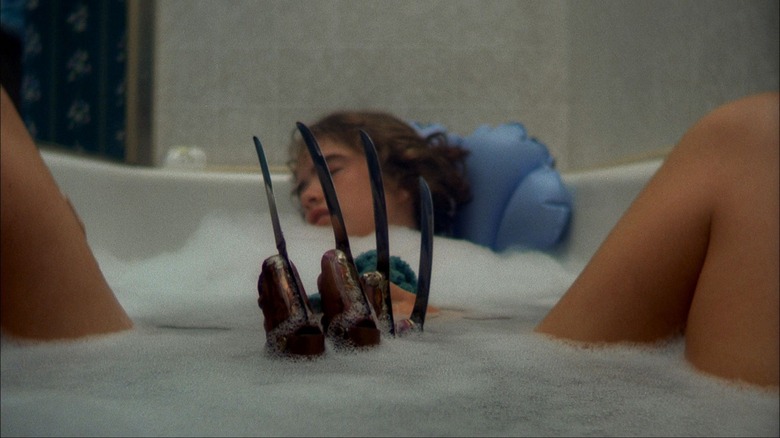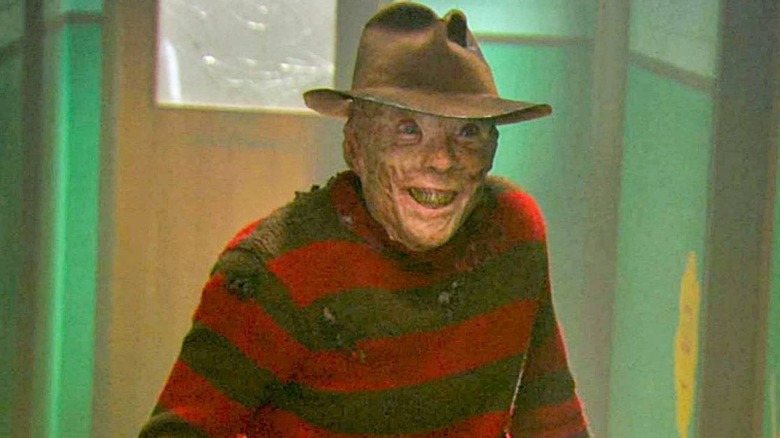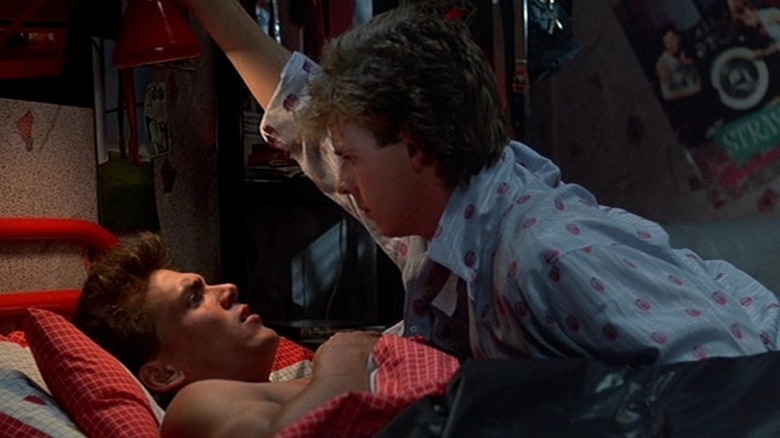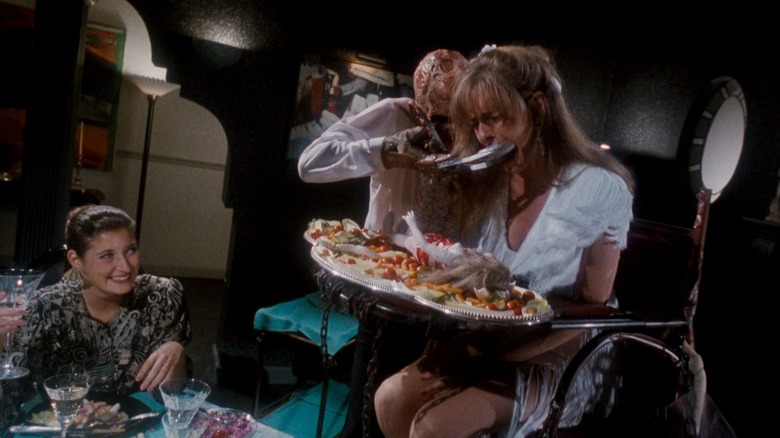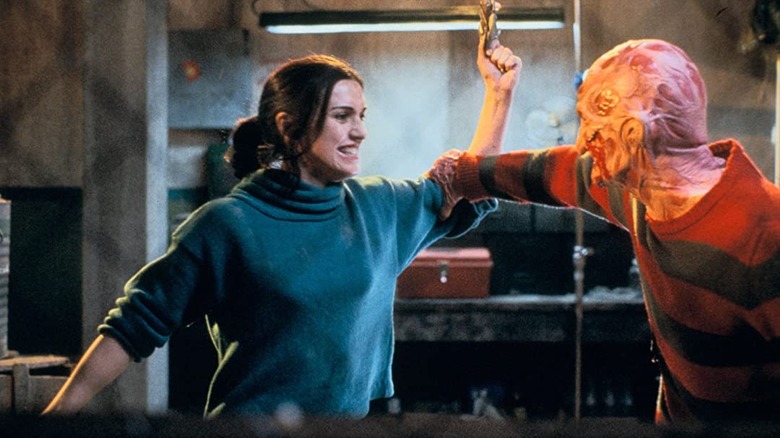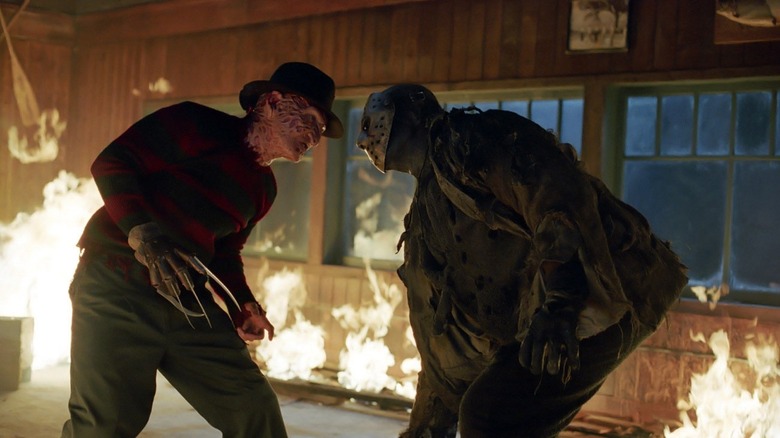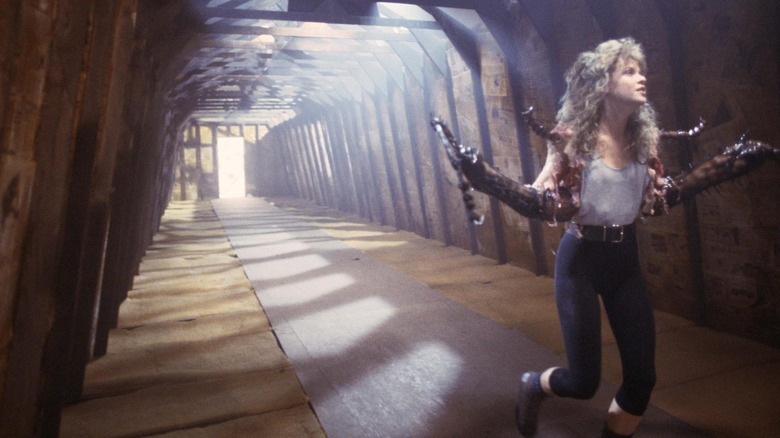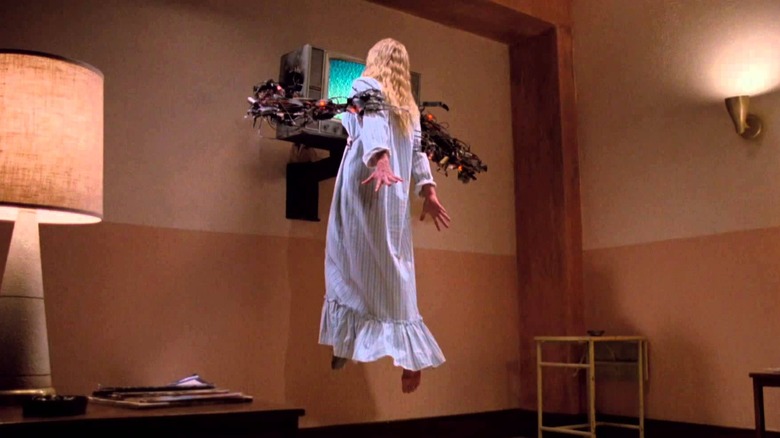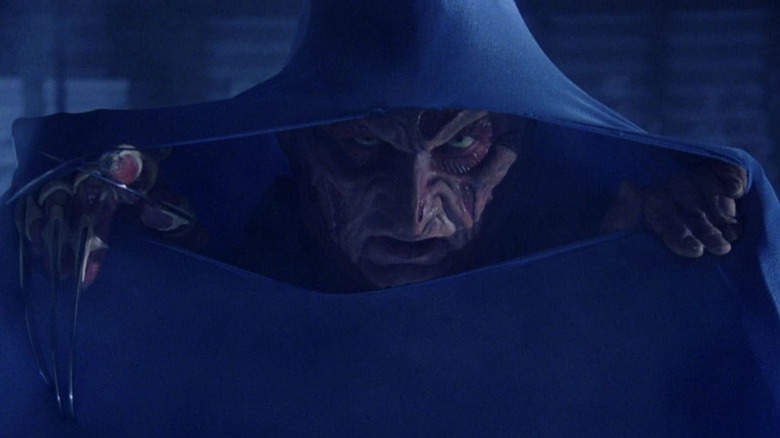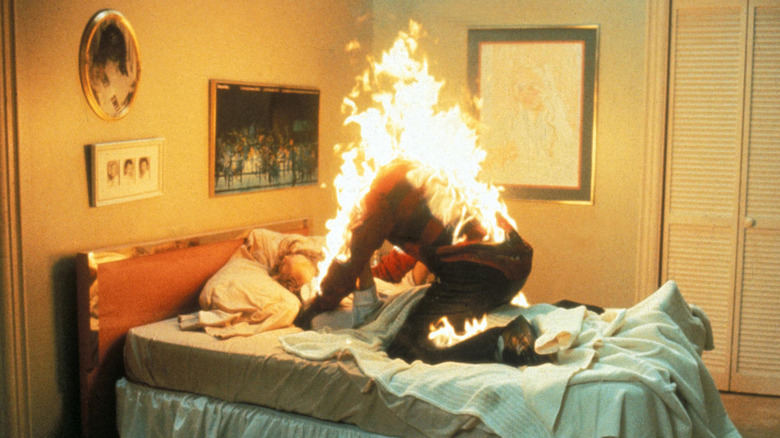Every A Nightmare On Elm Street Movie Ranked Worst To Best
Ranking franchise films is a challenging task because it forces you to consider different permutations of the same premise, spread out across time, with different actors and directors. "A Nightmare on Elm Street" is my favorite of the big three horror franchises (sorry, Jason and Michael), and while each film brings something unique to the table, not all of these entries are created equal.
It's impossible to discount the contributions of legendary film writer and director Wes Craven, who stepped in sporadically to shepherd, and even reshape, the series. But it would be unwise to give Craven all of the credit for the longevity of the films; after all, the series would be nothing without Robert Englund's inimitable performance as legendary horror villain Freddy Krueger, as well as the franchise's spectacular, often groundbreaking FX work and bombastic death sequences.
Overall the franchise has its ups and downs, but even the mid-tier "A Nightmare on Elm Street" entries have plenty to recommend and praise. For my money, there's only one true stinker in the bunch, so let's tackle that one right off the top and never speak of it again!
9. A Nightmare on Elm Street (2010)
The prevailing thought is that horror remakes are bad, but this isn't entirely true. Plenty of great horror remakes exist — from the '80s holy trinity of "The Fly", "The Thing," and "The Blob" to the messy glory of Platinum Dunes' 2003 "The Texas Chainsaw Massacre" and 1999's wacky "House on Haunted Hill" — but naysayers tend to focus on a few bad apples from the mid-aughts.
"A Nightmare on Elm Street" was the nail in the coffin of the early-2000s remake craze, and for good reason: It's atrocious. Casting Jackie Earle Haley as Freddy makes sense on paper, but onscreen it's clear that he lacks Englund's physically-imposing presence, and he never musters the true sense of malice required for the character.
What new ideas the remake does bring to the table, including the concept of micro-naps, never really lead to anything substantial. The 2010 film also offers terrible, unconvincing FX, and makes the uncomfortable decision to use Freddy's pedophilia as a plot point in the finale without taking the proper time to unpack it.
A few cast members emerge relatively unscathed by the experience: Katie Cassidy does great work with scant screen time and a paper-thin character, while genre MVP Kyle Gallner props up co-star Rooney Mara (and rocks a speedo, to boot). But if the film has one true failing, it's Mara herself, whose performance alternates between bored, sleepy, and disgruntled. It's the least inspired lead performance of the franchise and a deal-breaker in an already forgettable film.
8. A Nightmare on Elm Street 2: Freddy's Revenge (1985)
Let's be clear: All of the original films are worth watching, so don't read too much into the first sequel's low placement here. The reality is that "Freddy's Revenge" was a rush job ... and it feels like it. Arriving one year after Wes Craven's iconic first film, the 1985 sequel adventurously tries to take the franchise in a new direction: This is a possession film first, a sleep demon movie second.
When the Jack Sholder film hit theaters, it made a ton of money ($21 million on a $3 million budget), but its reception and reputation were much rockier. The campy tone and the malleable rules for how Freddy works — and Mark Patton's notorious final boy, Jesse — didn't fully land.
The issues on this sequel's set are now legendary, which makes some aspects of the film deeply uncomfortable to watch. In hindsight, this is homophobia captured on celluloid: David Chaskin was writing queer content into the movie without the consent of its closeted lead. It's nice that the fantastic documentary "Scream Queen! My Nightmare on Elm Street" is now available to set the record straight and showcase Patton's side of the story.
As for the film itself, "Freddy's Revenge" is half successful. Lisa (Kim Webber) taking over as lead in the last act is awkward, but the homoerotic tension between Jesse and Grady (Robert Rusler) and the queer themes remain important to a whole generation of LGBTQ+ audiences. This is a fun, albeit off-brand, entry in the franchise.
7. A Nightmare on Elm Street 5: The Dream Child (1989)
This is going to ruffle some feathers, but "The Dream Child" is a minor disappointment. The 1989 film is the fourth sequel in five years, and follows in the immediate aftermath of the narratively superior "Dream Warriors" and "The Dream Master," both of which have superior effects. The fifth entry in the franchise also delivered lower grosses than its two predecessors, pulling $22 million on an $8 million budget (still decent, but a far cry from the returns of parts three and four).
"The Dream Child" is basically Freddy's origin story, using Alice (Lisa Wilcox)'s pregnancy as a flashback delivery mechanism. Freddy's attempts to possess Alice's unborn child make the girl privy to visions of Freddy's mother, Amanda (Beatrice Boepple), being attacked and raped by 100 maniacs. This, along with Alice's opening nude shower scene and the film's heavy-handed pro-life message, makes "The Dream Child" one of the franchise's least female-friendly entries.
Even more so than in part four, there's a disjointed feel to the proceedings, as though we're jumping into the middle of an already-in-progress story. Alice's new friends are barely introduced before they're killed off, and Yvonne (Kelly Jo Minter), the film's only POC character, is frustratingly dumb and unsupportive.
Like many films in the franchise, "The Dream Child" does feature great FX and kill sequences. From Dan (Danny Hassel)'s fiery, body-horror motorcycle crash to Greta (Erika Anderson)'s forced feeding to Mark (Joe Steely)'s comic book death to Yvonne's gorgeous dive into space, the fifth "Elm Street" film continues the franchise's legacy of iconic dream sequences.
6. Freddy's Dead: The Final Nightmare (1991)
This film isn't good, but as the "final" entry in the series, there's a notable effort being made to wrap everything up, as well as to pay homage to the films that came before it. Director Rachel Talalay was a producer on the preceding films, so it made sense for New Line president Bob Shaye to entrust her to guide the franchise to a close.
"The Final Nightmare" has a bad reputation for many of the same reasons "Freddy's Revenge" does: It's much campier in tone than the other "Nightmare" films, frequently veering into comedy and even outright parody. While the campiness can be off-putting, the film's comedic bent does help it stand out. From Freddy doing Wicked Witch of the West drag to his use of increasingly large blackboards to torture disabled character Carlos (Ricky Dean Logan) to the mildly innovative use of the 3D gimmick in the finale, there's a kooky energy that runs through the entire film.
Arguably, the movie's greatest accomplishment is its subversion of expectations. The presumed lead is an amnesiac transient teen, John Doe (Shon Greenblatt), whom Freddy uses to lure his real progeny, Maggie (Lisa Zane), back to Springwood. Doe's mid-film death is a legitimately shocking development and plays with audience expectations built up over six previous films.
One wishes Maggie were a more memorable Final Girl, but overall "Freddy's Dead" is an oddball effort to balance Freddy's descent into parody while encapsulating the franchise's signature kills. An admirable swing and a miss for Freddy's so-called swan song.
5. Freddy vs Jason (2003)
After back-to-back perceived flops (every Freddy film technically made money), the house that Freddy built benched the dream boogeyman for nearly a decade. While the crossover between the "Friday the 13th" and the "Nightmare on Elm Street" franchises had been in the works since 1987, it still took more than 14 years and multiple false starts to bring these two titans of horror together on screen.
Helmed by Hong Kong director Ronny Yu (who had already proved he could balance competing tones with 1998's horror-comedy "Bride of Chucky"), "Freddy vs Jason" finds the two villains competing for the highest teen body count in Springwood. Caught in the middle of the epic grudge match are Lori Campbell (Monica Keena) and her friends, nearly all of whom die en route to a bombastic final battle that bridges the dream and real worlds.
"Freddy vs Jason" does an admirable job of balancing the wants of both franchises' fans and the finale is appropriately epic in scope. Sadly, the teens are a bunch of bland Red Shirts who exist primarily to get cut to ribbons, and the film disappointingly relies on CGI rather than practical effects. Kelly Rowland's purportedly improvised F-slur against Freddy has also aged poorly. But aside from these issues, the film is a solid crowd-pleaser that accomplishes what it needs to do.
Fun fact: This is also the top-grossing entry in both franchises.
4. A Nightmare on Elm Street 4: The Dream Master (1988)
If Wes Craven is integral to the franchise's best entries, then Renny Harlin deserves an understudy award, because there's absolutely no reason "The Dream Master" should work as well as it does. Harlin is the film's secret ingredient, contributing several of the nightmare sequences himself, as well as crafting Freddy's utterly ridiculous (yet iconic) resurrection by flaming dog urine.
As laughable and bizarre as it is, these weird details help make this fourth entry so memorable. "The Dream Master" suffered from several debilitating setbacks, including a complicated scripting process and the loss of lead actress Patricia Arquette. This necessitated a shift away from Kristen (now played by Tuesday Knight) to Alice (Lisa Wilcox), along with a brand new set of friends. This makes the film feel like the conclusion of "A Nightmare on Elm Street 3" and the beginning of something new — two films crammed into one. Despite these issues, "The Dream Master" feels more organically in line with its predecessor than any of the previous sequels (and balances two narratives better than part five).
When you think of part four, what comes to mind are the special effects. And while several sequences were filmed before Harlin was even brought on, the finished result includes many of the most iconic moments of the franchise: Kincaid's epic junkyard showdown, Joey's waterbed death (an ode to Glen from the first film), Debbie's disgusting cockroach transformation and Freddy's chest of souls in the film's climax. This one is a banger.
3. A Nightmare on Elm Street 3: The Dream Warriors (1987)
The spectacular third entry of the franchise refocuses the narrative on dying in your sleep. Wes Craven returns to co-write a script that moves the action out of the suburbs and into the Westin Psychiatric Institute as the series' mythology expands, allowing Kristen (Patricia Arquette) to pull allies into her dreams in order to combat Freddy.
The new setting is a key component of the film's success: "The Dream Warriors" keeps the crappy parents, but adds even crappier doctors into the mix. The asylum also raises the stakes because our new protagonists have virtually no control over their lives — or their meds — compared to the teens of the two previous films. This entry also marks the beginning of Freddy's controversial-but-popular shift into comedian territory, notable in his delivery of the iconic line "Welcome to Prime Time, bitch!" as he murders TV-obsessed Jennifer (Penelope Sudrow).
The second sequel also brings back MVPs Heather Langenkamp as Nancy Thompson (sporting a chic grey streak in her hair) and John Saxon as her deceased father. It boasts amazing FX and a deeply upsetting tone, which is particularly evident in Phillip (Bradley Gregg)'s vein-marionette walk off the roof and a giant Freddy slug slowly consuming Kristen. It should be noted that all of the kids are likable and feel like they legitimately care about one another, a rarity as the franchise ages. All things considered, it really is one of the all-time best horror sequels.
Two final pros? "The Dream Warriors" boasts a fantastic Dokken single and what is arguably the franchise's best poster.
2. Wes Craven's New Nightmare (1994)
The margin between the second and third best "Nightmare on Elm Street" is the slimmest of slivers. The fact that both directly benefit from series creator Wes Craven's involvement isn't surprising; what's most intriguing about "The Dream Warriors" and "New Nightmare" is how they take the ideas of the original film and advance them in such distinct, unique directions.
A mere three years after Freddy was bid a campy, 3D goodbye, Craven resurrected his '80s nightmare in the first of two game-changing metatextual horror films of the '90s. In hindsight, Craven's influence on "Scream" can easily be traced back to the ideas of "New Nightmare," which recontextualizes Freddy as an eternal demon who subsists not just on fear, but whose power is contained by fiction.
It's the perfect synthesis of the franchise's interest in how belief and memory keep Freddy alive, as well as Craven's fascination with the power of storytelling. "New Nightmare" also dispenses with the "bad parent" trope that defines the other entries in the franchise, as Heather Langenkamp (playing a cross between Nancy and herself) proves to be one of the most dedicated mothers the genre has ever seen.
Of course, none of this would matter if the imagery and FX weren't up to snuff. The pill-as-breadcrumb trail through the bottom of the bed and the film's "Hansel and Gretel" furnace finale alone help to cement "New Nightmare"s iconic status within the franchise.
1. A Nightmare on Elm Street (1984)
What more can be said about the importance of Wes Craven's original 1984 film? Not only did it introduce one of the genre's most memorable villains, it features one of horror's best Final Girls in Heather Langenkamp's Nancy Thompson.
The first entry in what would become a long-running franchise is a masterful example of slow-burning tension and savvy filmmaking. Robert Englund's villain is glimpsed primarily in shadow and brief flashes, so the film's focus remains fixed on Nancy, her boyfriend Glen (Johnny Depp and his infamous crop top), bad boy Rod (Nick Corri), and Nancy's best friend Tina (Amanda Wyss).
Not only are the dream sequences the stuff of actual nightmares, but Craven's ingenious way of shooting Tina's ceiling murder and Glen's exploding blood bed instantly catapults the film into top-tier horror territory. Add to this Nancy's shift into survival mode as she lures and traps Freddy in the real world: The character's cool confidence laid the groundwork for three decades of slasher movie protagonists, including Craven's own "Scream" survivor Sidney Prescott.
Arriving three years after the slasher boom of 1981, "A Nightmare on Elm Street" was a breath of fresh air for the saturated subgenre. Not only did it reinvigorate slashers with promising new visual and narrative possibilities, but Craven's definitive '80s masterpiece also changed horror forever. "A Nightmare on Elm Street" is a flawless American horror classic and genre staple, and undoubtedly the best film in the franchise.
